New Frontiers: Mercy Corps’ unwavering mission in Nguro Soye
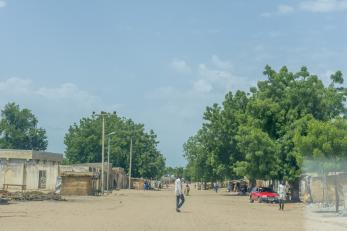
On Friday, April 28, 2023, Mercy Corps Nigeria team members were gearing up for the weekend when the email of the Country Director, Ndubisi Anyanwu, dropped. USAID had committed to funding the NE-CORE program in Ngala and Bama local government areas of Borno State. It was just one email, but it meant different things to several people. With the program not being implemented in Bama town but in Nguro Soye, it meant Mercy Corps will be the first international humanitarian organization to provide assistance to the residents of the ward. It signified the beginning of a new chapter for the community, a chapter filled with possibilities and opportunities.
The comprehensive multi-sectoral program will extend support to approximately 2,000 households in Nguro Soye, encompassing food assistance, WASH, protection, nutrition, shelter and resettlement, cash assistance, and agricultural initiatives. For me, it meant the beginning of a new storytelling journey.
A story that leads to Nguro Soye, or simply Soye, once a vibrant ward nestled in the Bama.Like many other towns in the region, Soye has a tale of two eras, each marked by stark differences. In the pre-insurgency era, the town flourished with an economy centered around agriculture. Crops such as millet, sorghum, and peanuts thrived, and livestock farming was also prevalent. However, the arrival of Boko Haram in 2009 unleashed a wave of destruction, death, and displacement, leaving Soye a ghost town by 2014. With relative stability gradually returning to Bama LGA since 2015, signs of life began to reemerge in Soye.
Recent developments saw the state government initiate decongesting IDP camps by relocating around 1,300 displaced persons to Soye, as reported by the United Nations Office for the Coordination of Humanitarian Affairs (OCHA). This is the story of Soye.
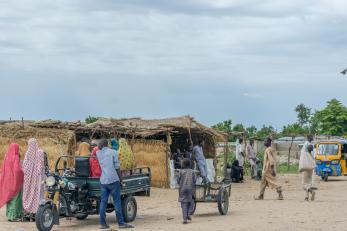
NE-CORE is not like any other program, the location alone makes it unique, and extensive groundwork must be undertaken before implementation can begin. To ensure a smooth program implementation, a delegation from the Technical Support Unit (TSU) of Mercy Corps Nigeria was sent to Bama. The Shehu of Bama, the revered traditional head of the region, warmly welcomed the delegation and expressed his enthusiasm, stating, “the relocation to Nguro Soye is a timely move that will have a significant impact. I pledge my full support to your efforts.” Engaging with community leaders from Soye, the delegation highlighted shelter as a primary need, along with concerns regarding WASH, food security, and agricultural support.
While conversations with the leaders gave an overview of the context, my curiosity was piqued and my interest was sparked by the desire to hear about the thoughts and sentiments of the people who will be directly reached by the program in the next 24 months.
The Mercy Corps team received a warm reception in Soye, evident by the crowd gathered at the residence of the acting district head, Zanna Babagana. Expectations were high. While other team members were on a quest to assess and register program participants, I was out to hear the “voices on the streets.” At first, I stood still, not knowing which way to go. Luckily, Abubakar Mustapha, a 27-year-old community member, volunteered to serve as my tour guide. He dedicated himself to taking me around while providing valuable insights into the challenges faced by the community.
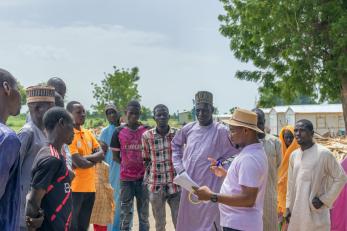
The first place Abubakar led us to was the residence of Bintu Ali, a 37-year-old mother of two, who shared her excitement, stating, “I didn't go to my farm today because I heard Mercy Corps was coming to register participants, and I don't want to miss out.” Bintu was displaced from her village, Kumshe, and relocated to Soye in 2021. She emphasized the immense needs in the community, explaining, “to survive, we must venture into the forest to gather firewood for sale. When we can't find wood, we go to bed hungry.”
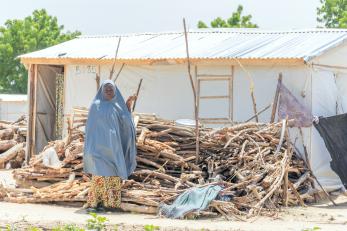
This activity not only poses a grave threat to the safety of Bintu and thousands of people but also contributes to climate change. The felling of trees for firewood leads to deforestation, affecting the environment and exacerbating the effects of climate change. Bintu highlighted her greatest challenge as the lack of food, stating, “as IDPs, it's difficult to access farmland since most lands belong to the community.” Access to water is also a challenge faced by Bintu and many others. Bintu shared, “during the dry season, we are unable to get water from the handpump and have to walk for almost an hour to fetch water.”
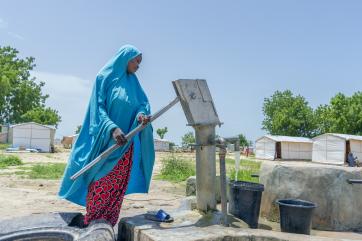
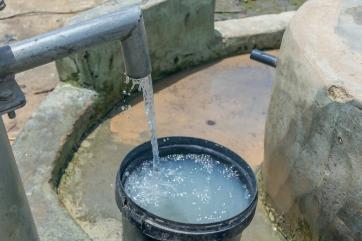
Our journey also led us to Kellu Umar, another IDP who expressed her concern about the quality of water in their community, “the water from the handpump is usually discolored, and that's not how water should naturally look,” she said. When asked how she meets her dietary needs as a nursing mother, Kellu, who carries a 10-month-old baby, replied, “I can't remember the last time I had fresh or nutritious food. I struggle to have enough food to feed myself, and can't afford it right now.”After my conversation with Kellu, I asked to speak with a member of the host community and Abubakar led me to Mohammadu Kami’s residence.
On the way, Abubakar highlighted critical protection concerns in Soye. He shared a tragic incident, stating, ”a young girl recently passed away under distressing circumstances. She was married off as a child, and her husband claimed she complained of stomach ache before her untimely demise.” Additionally, he shed light on the community's ongoing struggle to address cases of domestic violence as we approached Mohammed’s house.
Mohammadu Kami, a member of the host community, was once a prominent onion farmer in Soye. However, like millions of others, the insurgency has put an end to his trade. Reflecting on his situation, he shared, ”I am in my seventies; I don't have the physical strength to engage in income-generating activities and have to depend on the goodwill from people to survive.” Mohammadu's story highlights the dire circumstances faced by many individuals in Soye. With a pressing need for food assistance and cash support to meet their daily needs.
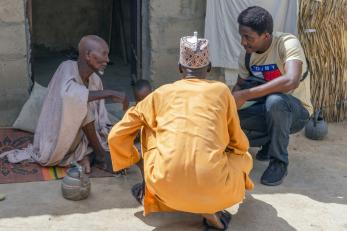
“If you're not too tired, I'd like to take you to see some shelters that have been damaged by the rain,” Abubakar suggested after my conversation with Mohammadu. Sensing his enthusiasm, I replied, “absolutely, let's go.” When IDPs were returned to Soye, the Borno State Ministry of Reconstruction, Rehabilitation, and Resettlement (MRRR) constructed Bama-type shelters for them.As we walked, Abubakar proudly shared the staggering statistics of the destruction caused by the wind. “The wind has ravaged 238 shelters and 26 toilets,” he remarked, carefully consulting his worn-out notepad to ensure the accuracy of his information.
“Where do the affected people live now?” I asked. Abubakar explained that they have had to rely on the kindness of those with intact shelters to accommodate them before introducing me to Yakura Kolonda, whose shelter had been destroyed. She shared her story, saying, “my original house in the community was destroyed years ago, and now this shelter has been ruined by the rain. Thankfully, my neighbor has generously taken us in, providing shelter for me and my four children.”
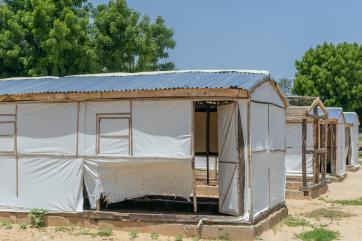
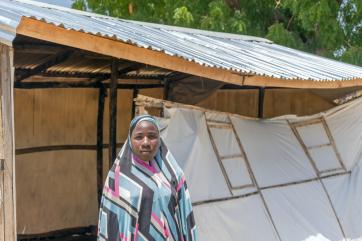
As we left Yakura's place, I noticed her pregnant appearance. "Where do pregnant women go for antenatal care in Soye?” I asked. Abubakar's response was disheartening. "We don't have any health facilities in Soye,” he remarked. “The closest hospital is in Bama town, and most women give birth at home,” he continued. “An NGO built a hospital here but it’s abandoned and not in use,” he concluded.
Apparently, all of Soye's medical needs are managed through the local drug store and our next action was a rather lengthy 20-minute walk to the drugstore. Unfortunately, the owner was not present at the time, but after obtaining permission from his children, I took some pictures to document the situation before we left.
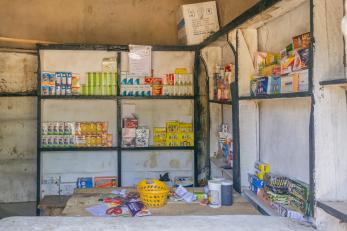
After several hours of exploring Soye, Abubakar and I found ourselves back at the residence of Zanna Babagana, the acting district head. Saying goodbye to Abubakar was unexpectedly emotional. We had spent the entire day together, and now our time had come to an end. Before leaving, I asked the district head if we could visit the unused health facility. With only 60 minutes left in Soye, I felt a strong desire to see the place for myself. Zanna kindly agreed, and we hopped into his old golf vehicle for the short ride to the site.
During the journey, I took the opportunity to learn more about the history of Soye and how the insurgency had transformed the community. Zanna shared, “Soye was once a thriving settlement of farmers. Before the insurgency, the entire Borno State recognized Soye as a major producer of onions, carrots, maize, and millet.” His face beamed with pride as he reminisced about the glorious past of Soye and its agricultural prowess.
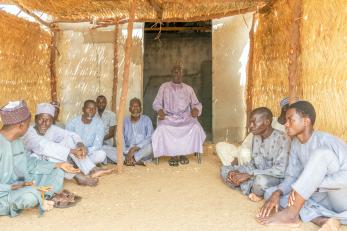
As Zanna began recounting the impact of the insurgency on the community, a somber tone overshadowed his earlier pride. He shared the harsh realities faced by the people of Soye, saying, “accessing our farms has become impossible. Anyone who dares to plant outside the military parameter is essentially farming for the insurgents. They will harvest the crops for themselves. Now, nearly everyone relies on felling firewood in the forest for sale, which not only poses a serious threat to the ecosystem but also puts their lives at risk. There have been instances of insurgents attacking, robbing, and even killing those engaged in this activity. I remember a woman was once stripped naked by them, and she had to come to town without clothes.”
As we reached the health facility, a sense of quietude enveloped the surroundings. The building stood silent and unused, not the grandest of health facilities but a significant upgrade on the local drug store and a symbol of what could have been if it were functional and accessible to the community. Yakura will have antenatal care, Kellu wouldn’t have had her last child at home and the narrative of several others would have been different. I couldn't help but imagine the potential it held in providing essential healthcare services to the people of Soye. Thankfully, discussions are ongoing with various stakeholders for Mercy Corps to activate the facility.
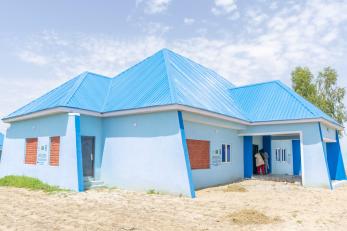
The district head and I made it back just in time to catch the departing Mercy Corps team members, as we needed to leave Soye by 3pm due to security concerns. As we drove out, I insisted on a quick stop at the supposed Soye market. It was a stark contrast to the bustling markets typically found in northern Nigeria. It appeared lifeless and quiet.
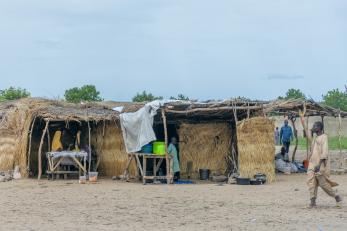
Returning to the guest house, I realized that my story was not yet complete. While I had a general understanding of the NE-CORE program framework, I needed to hear directly from the Mercy Corps team members about their plans for implementing it in Soye. My first destination was the office of the Senior Program Manager, Bala Joseph.
I had just one question for Bala: How will the program bring about sustainable solutions to the challenges in Soye? His response was clear. “All our interventions will employ climate-smart technologies and carry climate-friendly sensitization messages,” he began. “The crux of our intervention will be to utilize available structures and complement the efforts of the government. Our intervention in Soye combines humanitarian assistance with durable solutions. Our ultimate goal is to restore Soye to its glorious days,” he continued.
Furthermore, he explained, “the integrated approach of the program will ensure that each sector builds upon the other to provide sustainable solutions to the participants. We will begin by providing food assistance and then transition participants to agricultural activities. This will be complemented by nutrition activities such as distributing supplementary nutrition to pregnant and lactating women, along with counseling and cooking demonstrations. Simultaneously, we will implement WASH and Shelter interventions. The MPCA component will provide direct cash assistance, immediately reducing the reliance on wood felling as a primary source of income, while also integrating protection activities. All interventions will prioritize the use of locally available products, and fuel-efficient stoves will be distributed to replace wood as a source of fuel.”
“Our interventions will utilize a voucher system that engages local vendors, building their capacities to meet program requirements. This approach also generates economic activity by injecting money into the local market, revitalizing the economy. We have seen this model succeed in Damboa and Bama and we are confident it will work in Soye,” he added.
When asked about his feelings regarding the unexplored Soye, he expressed, “it is a mixed feeling. I am unsure about the security situation, but my drive to serve humanity outweighs any fears I may have. I am going to Soye as a happy person with a sense of fulfillment.”
To gain insight from other team members, I inquired about their thoughts. Mohammed Madu, the CASH assistant, shared, “Initially, I was apprehensive, but after visiting and seeing what Soye is like, I feel relieved. The presence of a security post and the overall atmosphere make it feel no different from Bama town.” Bukola Adelakun, the Nutrition officer, expressed enthusiasm, stating, “it is a new experience, and I am excited to meet the needs of the people.”
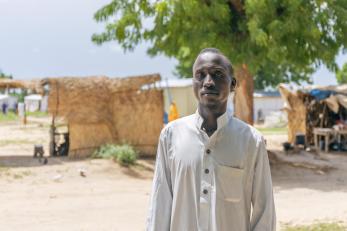
From my findings, it is evident that Soye is ready for change. The community is resilient and willing to rebuild. The leaders are committed to their people, the Mercy Corps team is enthusiastic, and the government is supportive. The next twenty-four months are primed to come with renewed hope for the people of Soye. It is a time of hope and opportunity with sustainable development and assistance coming to the once forgotten community.
Reflecting on the day's experiences, I felt a mix of emotions. It was heart-wrenching to witness the hardships faced by the residents, yet inspiring to see their resilience and the support they offered one another. The memories of the people I met, their stories, and their unwavering spirit will forever remind me of the urgent need to continue supporting communities affected by conflict, helping them rebuild, and restoring the prosperity they once knew.